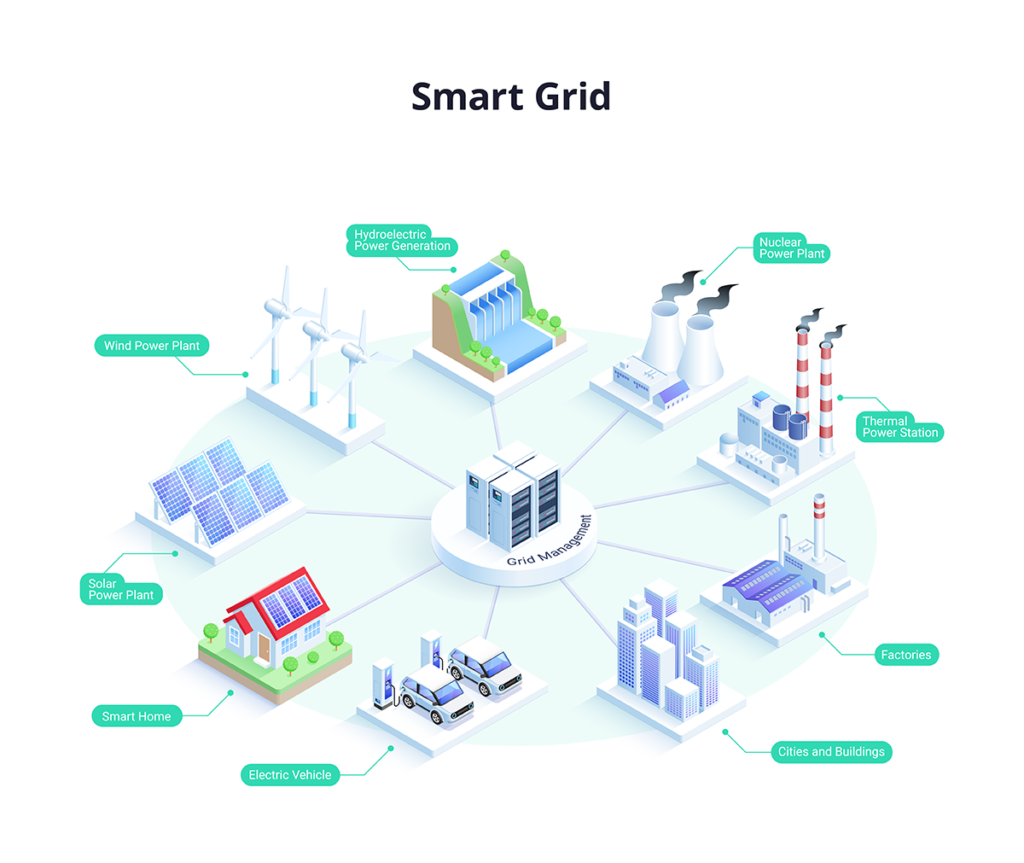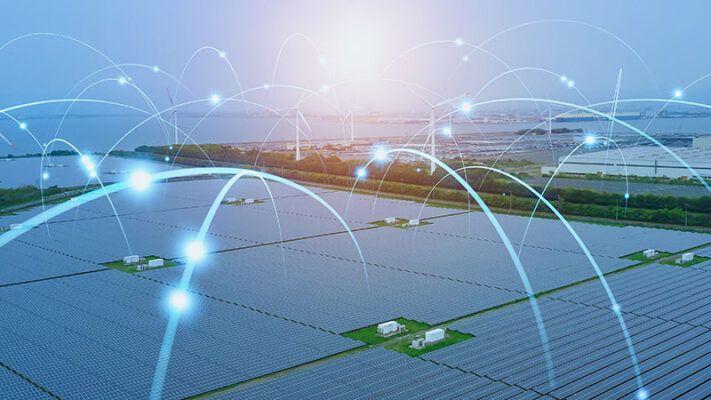Anúncios
In a world where technology is shaping every facet of our lives, one cannot overlook the significant role it plays in the energy sector. Harnessing the power of smart grids, we are on the brink of a paradigm shift in the way we consume and generate power. This revolutionary technology, touted as the future of energy, is reshaping the landscape of sustainable power, influencing how we interact with and use energy in our daily lives.
In the wake of the global energy crisis, finding more sustainable and efficient ways to manage power is critical. Enter the era of smart grids – an intelligent, interconnected network that revolutionizes energy consumption. With the ability to monitor real-time usage, smart grids not only help in efficient energy management but also contribute to reducing carbon footprints.
Anúncios
This piece takes an in-depth look at smart grids, providing a comprehensive understanding of how they are poised to change the face of energy usage. From explaining the concept of smart grids to exploring their benefits, and the challenges that lie ahead, every aspect is meticulously covered.
The potential impact of smart grids on renewable energy sources is particularly noteworthy. Their ability to integrate seamlessly with renewable sources such as wind and solar power is a game-changer, contributing to a more sustainable and cleaner energy future.
Anúncios
Indeed, smart grids are no less than a revolution in the power industry. Their adoption has the potential to redefine our energy practices, making power consumption more efficient, sustainable, and in tune with the digital age. Thus, the future of energy is not only smarter but also more sustainable, thanks to smart grids. So, join us in exploring this exciting frontier in the energy sector, and discover how it promises to power the future.
Understanding Smart Grids
Let’s begin with a basic understanding of smart grids. In simple terms, smart grids are an evolved version of the traditional electrical grid system. They are equipped with digital technology that allows for two-way communication between utilities and customers. This advanced communication system paves the way for an efficient exchange of information about power usage, enabling utilities to deliver electricity more reliably and sustainably.

To fully appreciate the revolutionary impact of smart grids on energy usage, it is critical to understand the limitations of traditional grid systems. Traditional grids are often unidirectional, with electricity flowing from power plants to consumers without any feedback mechanism. Any imbalances or faults in the system can cause power outages or fluctuations, leading to significant losses. Moreover, these older systems often lack real-time monitoring, making it difficult for energy providers to detect anomalies or prevent blackouts effectively.
Smart grids, on the other hand, feature real-time monitoring, control systems, and data analysis tools that allow for immediate detection and rectification of faults. They are designed not just to distribute energy, but to manage energy intelligently — optimizing supply based on demand, integrating renewable sources, and enhancing the stability and resilience of the grid.
Key Components of Smart Grids
Smart grids are composed of several key components that work together to create a smarter, more efficient energy infrastructure. Let’s explore each of these components in greater detail.
1. Digital Technology
Digital technology is the foundation of smart grids. It facilitates two-way communication between energy providers and consumers, enabling dynamic data exchange. This interaction is essential for energy management, demand response, and personalized energy solutions.

For example, smart grids allow utilities to send real-time pricing information to customers, encouraging them to adjust their consumption during peak hours, leading to energy savings and lower operational costs. In addition, digital platforms allow users to monitor their energy usage through mobile apps or web portals, fostering a culture of energy awareness and sustainability.
2. Sensors and Smart Devices
Sensors, smart meters, and IoT (Internet of Things) devices are integral parts of smart grids. These devices constantly collect data about the grid’s performance, energy flow, consumption patterns, and even the status of individual components.
This real-time data collection enables predictive maintenance, where the system can identify potential equipment failures before they happen, reducing downtime and maintenance costs. Sensors installed on transmission lines or transformers can detect overheating, overloads, or physical damage — sending alerts instantly for faster resolution.
3. Advanced Metering Infrastructure (AMI)
Advanced Metering Infrastructure (AMI) provides utilities with real-time or near-real-time data about power consumption at both residential and commercial levels. Unlike traditional meters that require manual reading, smart meters automatically transmit usage data to the utility company.
This not only eliminates the need for manual meter reading (reducing operational costs), but also allows for time-of-use pricing, remote disconnection or reconnection, and quicker response to power outages.
Consumers also benefit from AMI through greater control over their energy consumption, real-time cost estimation, and the ability to participate in energy-saving programs offered by utilities.
4. Distributed Generation and Renewable Integration
One of the most transformative aspects of smart grids is their ability to integrate distributed generation — allowing energy to be generated closer to where it is consumed. This includes renewable sources like solar panels on rooftops, wind turbines in local communities, or bioenergy systems in rural areas.
Traditional grids were not built to handle multiple small-scale producers feeding electricity back into the grid. Smart grids, however, are designed with this flexibility in mind. They allow for bidirectional energy flow, enabling homeowners, businesses, or local producers to supply surplus energy back to the grid, promoting energy decentralization and sustainability.
Furthermore, smart grids use energy storage systems, like batteries, to store excess renewable energy for later use — addressing the intermittent nature of wind and solar power.
5. Energy Management Systems (EMS)
Energy Management Systems are software platforms that analyze the data gathered from sensors, meters, and IoT devices. They help utilities make informed decisions about energy generation, distribution, and load balancing.

In large-scale operations like smart cities, EMS can coordinate traffic lights, public transportation, building management systems, and street lighting to optimize energy use throughout the urban infrastructure.
Final Considerations
In essence, smart grids represent a comprehensive, technology-driven upgrade to outdated power infrastructure. They are the backbone of the future energy landscape — capable of enhancing grid stability, reducing operational costs, integrating clean energy, and empowering consumers.
By combining advanced communication systems, real-time monitoring, automation, and renewable integration, smart grids pave the way for a more sustainable, resilient, and intelligent energy future.
Role of Smart Grids in Sustainable Power
As global demand for electricity continues to rise, driven by urbanization, population growth, and the electrification of sectors like transport and heating, the need for sustainable power solutions has never been more urgent. Smart grids play a pivotal role in transitioning from fossil-fuel-based energy systems to more decentralized, resilient, and renewable-based infrastructures.
Traditional power grids were engineered for a one-way energy flow—from large, centralized power plants to passive consumers. This model struggles to accommodate distributed energy resources (DERs) such as residential solar panels, wind farms, micro-hydro units, and community bioenergy systems. Smart grids, however, are built to handle this complexity.
By integrating advanced sensors, communication technologies, and automation, smart grids allow for real-time coordination between generation, storage, and consumption points. They can efficiently manage the intermittency of renewables—like the drop in solar output during cloudy periods or reduced wind speeds—by instantly adjusting the supply using backup storage or flexible loads.
Moreover, smart grids enable dynamic balancing of supply and demand, improving grid stability and reliability. This is crucial for high-penetration renewable scenarios, where fluctuations are common. Smart grids also support microgrids, which are localized energy systems capable of operating independently in case of main grid failure—further enhancing energy security.
The integration of renewables through smart grids not only reduces greenhouse gas emissions and air pollution, but also fosters energy democratization. Citizens and communities can become “prosumers,” generating their own electricity and feeding the surplus into the grid. This can stimulate local economies and promote greater public participation in climate action.
Enabling Energy Efficiency and Demand Response
One of the defining features of smart grids is their ability to empower consumers. Through real-time data, smart grids provide unprecedented visibility into energy usage, enabling both utilities and end-users to make smarter, more sustainable choices.
Smart meters are the cornerstone of this transformation. By collecting and displaying granular consumption data, they allow households and businesses to understand when, where, and how they use electricity. This transparency encourages behavioral changes, such as shifting high-energy tasks (like running dishwashers or EV charging) to off-peak hours, which helps flatten demand peaks and reduce stress on the grid.
Beyond awareness, smart grids enable automated efficiency solutions. For instance, smart thermostats can adjust heating or cooling based on occupancy patterns and real-time pricing signals. Smart appliances can be programmed to operate when energy is cheapest or cleanest. Buildings equipped with energy management systems can continuously optimize consumption across lighting, HVAC, and other systems.
Demand response programs take this one step further. Instead of just managing consumption individually, they coordinate energy usage across entire regions. Utilities or aggregators send signals (such as price incentives or alerts) to encourage users to reduce or shift their energy use during peak demand periods. This reduces the need for peaker plants—expensive, carbon-intensive facilities that are only used during high-demand moments.
For example, during a heatwave when air conditioners push demand to the brink, a utility might offer discounts to customers who allow slight temperature adjustments for a few hours. On a larger scale, industries might pause non-critical operations in exchange for financial compensation. These flexible responses help maintain grid balance without resorting to environmentally harmful or economically inefficient solutions.
Incorporating battery storage and electric vehicles (EVs) further enhances demand response. Smart grids can draw energy from home batteries or EVs during peaks and recharge them during troughs, essentially turning distributed assets into active grid participants.
Ultimately, the efficiency gains enabled by smart grids result in lower energy consumption, reduced emissions, and cost savings—benefits that align with both environmental goals and economic interests.
The Future of Smart Grids
As the world continues to grapple with the dual challenges of increasing energy demand and climate change, the role of smart grids in the energy landscape is set to become even more critical. While the technology has made significant strides over the past few years, there is still a considerable scope for advancement.

Emerging technologies such as artificial intelligence (AI), machine learning, and blockchain hold immense potential to enhance the functionality and efficiency of smart grids. For instance, AI and machine learning can be used to predict energy demand, optimize grid performance, and detect faults even more accurately. Similarly, blockchain can ensure secure and transparent energy transactions.
Barriers to Smart Grid Implementation
Despite their numerous benefits, the widespread adoption of smart grids is not without challenges. These include technical issues such as cybersecurity risks, interoperability concerns, and the need for a robust communication infrastructure. There are also regulatory and policy challenges, as well as the need for significant capital investment.
Nevertheless, with the right strategies and support, these challenges can be overcome. The benefits of smart grids – from improving grid reliability and promoting energy efficiency to enabling the integration of renewable energy – are too significant to ignore. As we move towards a more sustainable energy future, smart grids will undoubtedly be at the heart of this transformation.
Conclusion
In conclusion, the revolution in energy usage brought about by smart grids is undeniably reshaping the landscape of sustainable power. As we strive towards a more sustainable future, it is clear that these advanced technologies are not only improving the efficiency of energy distribution but are also fostering a more significant shift towards renewable energy sources. The potential of smart grids is vast, from reducing our carbon footprint to empowering consumers with the ability to manage their energy usage more effectively.
By leveraging data and automation, these grids are transforming traditional power systems, making them more responsive and adaptable to the changing energy needs of the future. This new energy paradigm not only benefits consumers but also promotes environmental stewardship, contributing directly to global efforts to mitigate climate change.
However, as with any technological advancement, it is crucial to navigate potential challenges, such as data security, privacy concerns, and the need for significant infrastructure investment, to ensure the successful implementation of smart grids. Collaborative efforts between governments, industries, energy providers, and consumers will be essential to overcome these barriers and accelerate the global transition.
Ultimately, the future of sustainable power is bright, driven by innovation, digitalization, and a shared commitment to environmental responsibility. Smart grids symbolize much more than technological evolution — they represent a critical step forward in building a smarter, greener, and more resilient world. As we continue to power the future, embracing smart grids will be vital in shaping a cleaner, more efficient, and sustainable energy ecosystem for generations to come.

